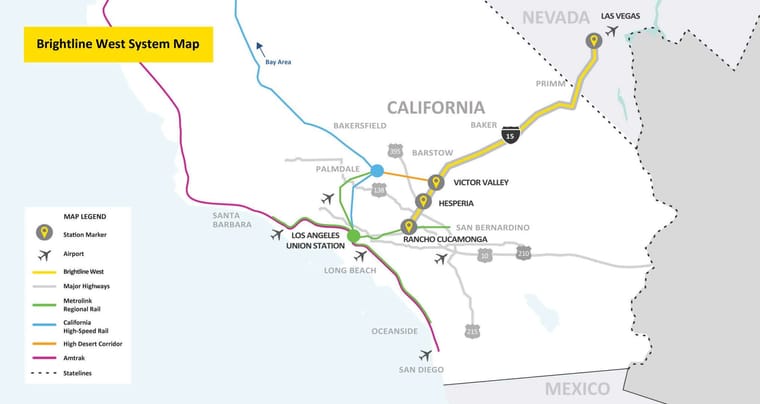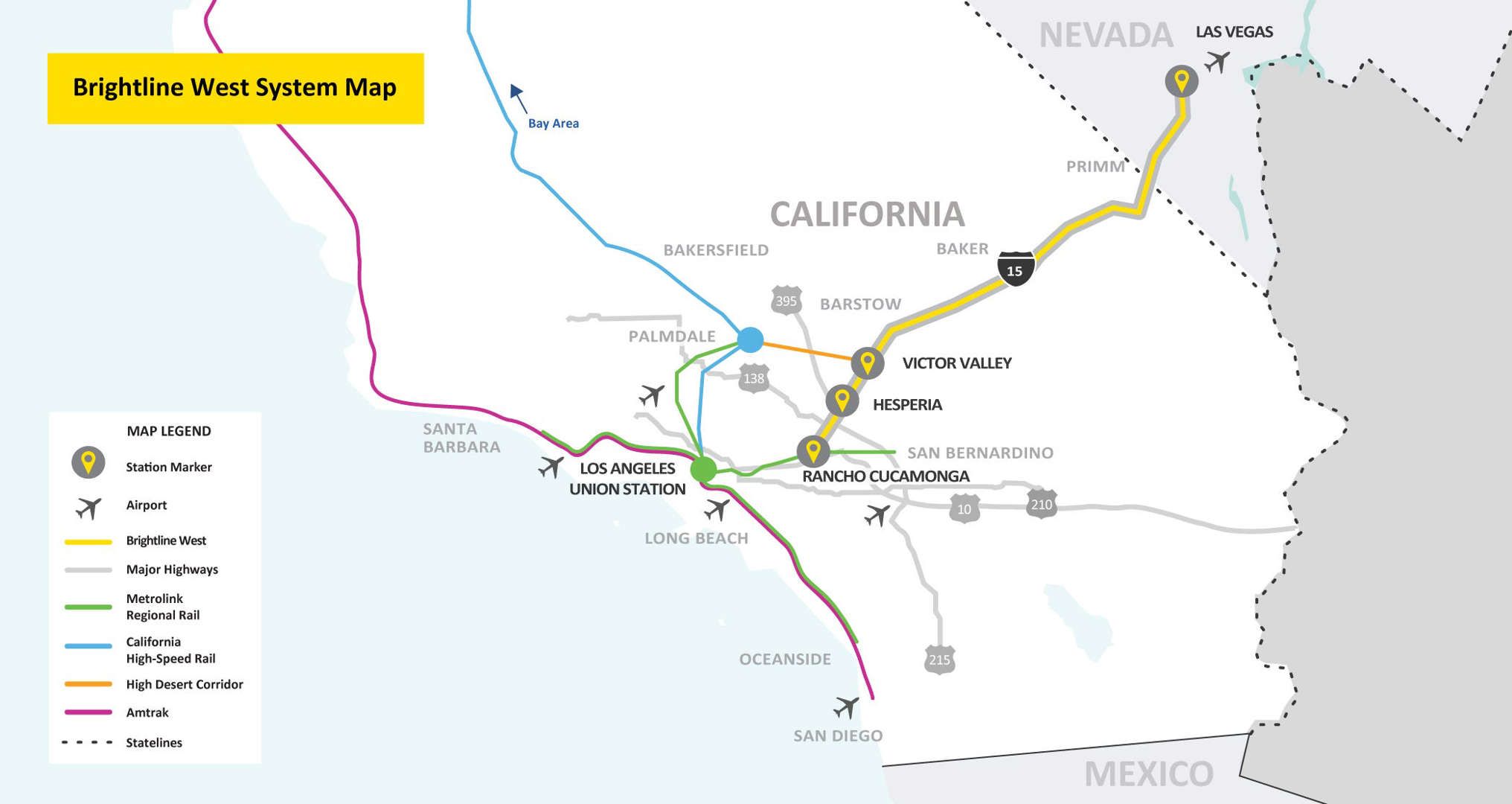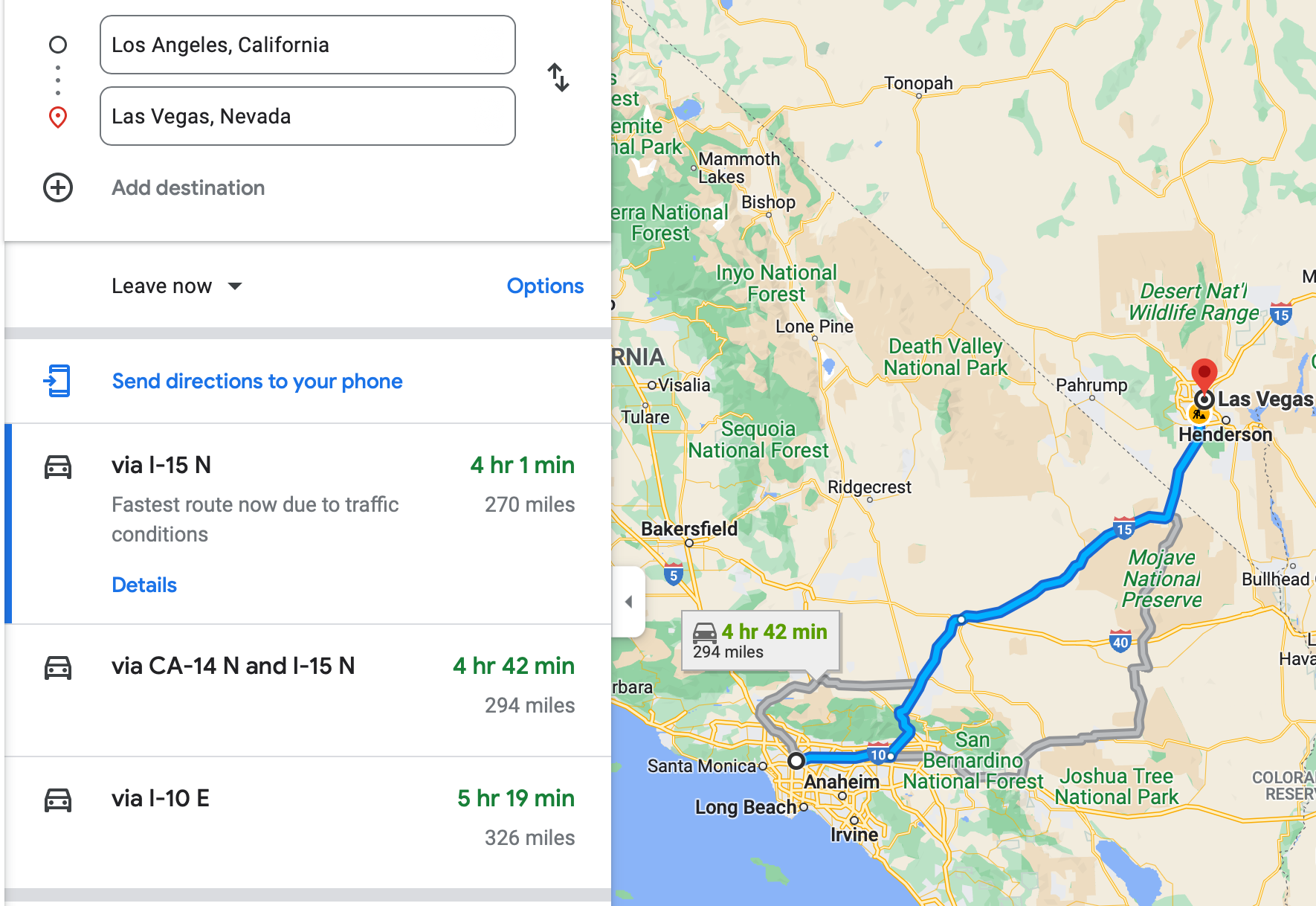Vegas to LA in 2 hours
-
Yeah, more high-speed rail. The difference is that this is a private company (Brightline) with a pretty good record in Florida.
A Miami-based company intends to offer a third option that sounds like something out of Switzerland or Japan: a high-speed train that will cover 218 miles between Las Vegas and the Los Angeles area in two hours and 10 minutes.
"There will be a train in the United States operating in excess of 186 miles an hour in the very near future," Mike Reininger, CEO of the company planning to build the train system, said last week at a high-speed rail conference in Washington D.C.
Start the day smarter. Get all the news you need in your inbox each morning.
"It is the only fully shovel-ready project that can be delivered in short order in the United States," he said, adding that he hopes the project "will finally plant the flag of what high-speed rail in America can and should look like."
Reininger announced that the project will be ready for groundbreaking by the end of the year and will be finished by the 2028 Olympic Games in Los Angeles.
"If you were gonna come out and put yourself on the stage, is there a better way to do that than at the opening ceremonies at the '28 Olympics?" he said. "That is our objective."
The high-speed rail is estimated to cost $12 billion, 70 percent of which will come from private investment. Reininger's company, Brightline West, hopes the other 30 percent will come from the federal government.
Last month, Brightline West applied for a $3.75 billion grant from the Biden administration to fast-track the project. The grant proposal was 4,500 pages, Reininger said, adding that the company has more than covered its bases.
Shortly after applying for the grant, a bipartisan group of California and Nevada lawmakers wrote a letter to U.S. Transportation Secretary Pete Buttigieg expressing their strong support of approving the dollars.
"This unprecedented funding opportunity for intercity high-speed rail will unleash private investment at a critical moment for our nation, demonstrating the potential for public-private partnerships and planting a flag for American high-speed rail," the lawmakers wrote.
They went on to praise the rail plan for job creation, the environment and the potential to boost tourism across the region.
In order to meet the goal to open the rail before the 2028 Olympics in Los Angeles, Brightline West will have to lay about a mile of track a day for 270 days following years of preparation, according to company estimates.
In all, the company will use 70,000 tons of rail and 750,000 railroad ties for the rail, which will be electric.
"We think it will be the greenest form of transportation anywhere in the world," Reininger said.
Another component he's proud of is Brightline West's commitment to use union workers during the project and once it's finished.
The line will include three stations, with the two main ones being in Las Vegas and the Los Angeles suburb of Rancho Cucamonga. The third one will be roughly halfway in between in Victorville, California.
"We have invested, to date, over $600 million of entirely private funding into acquiring all of the critical land and completing the right of way from endpoint stations for the entire system," Reininger said. "We have that under control today."
Once finished, the system will be capable of transporting 11 million people a year, he said.

-
High speed rail is the third rail of infrastructure projects in America.
-
I'm not sure why that is worthwhile. You can drive it in 3 without having to go to a train station.
-
Ah, but you are starting in LA, 294 miles, and his train starts east of there in Rancho Cucamonga. It only covers the last 218 miles. So if you are thinking starting in LA, you still have from LA to the train station, and that is where the traffic hassles will be. I still don't see the advantage.
-
Ah, but you are starting in LA, 294 miles, and his train starts east of there in Rancho Cucamonga. It only covers the last 218 miles. So if you are thinking starting in LA, you still have from LA to the train station, and that is where the traffic hassles will be. I still don't see the advantage.
@Mik said in Vegas to LA in 2 hours:
Ah, but you are starting in LA, 294 miles, and his train starts east of there in Rancho Cucamonga. It only covers the last 218 miles. So if you are thinking starting in LA, you still have from LA to the train station, and that is where the traffic hassles will be.
Good point. LA Metro rail is 1:20 from LA Union Station to Rancho Cucamonga.

ETA: At 7AM LA time the drive is about the same.
ETA (again): At the moment, the drive from Rancho Cucamonga to Vegas is 3:27 minutes for 229 miles on I15.
-
Ah, but you are starting in LA, 294 miles, and his train starts east of there in Rancho Cucamonga. It only covers the last 218 miles. So if you are thinking starting in LA, you still have from LA to the train station, and that is where the traffic hassles will be. I still don't see the advantage.
-
@Mik said in Vegas to LA in 2 hours:
I still don't see the advantage.
You can get good and drunk on the train.
@Copper said in Vegas to LA in 2 hours:
@Mik said in Vegas to LA in 2 hours:
I still don't see the advantage.
You can get good and drunk on the train.
Well, yes, and no.
On Amtrak, you can drink as much as you want. However, if you become disruptive, you will receive a warning. You might even receive two warnings. If it continues, “ the next stop, will be your stop,”
-
I think there's a market for it. TONS of LA folks go there for short trips (not least, strippers). This makes it feasible to go for a day trip and sleep off the alcohol on the way home.
Reminds me of the ferry from Hong Kong to Macau. Go party until 4am, and come back.
-
I think there's a market for it. TONS of LA folks go there for short trips (not least, strippers). This makes it feasible to go for a day trip and sleep off the alcohol on the way home.
Reminds me of the ferry from Hong Kong to Macau. Go party until 4am, and come back.
@Jon said in Vegas to LA in 2 hours:
I think there's a market for it.
As I mentioned, Brightline has done well in Florida. They are hampered because of their need to use pre-existing right-of-way. Here, they're planning to build their own, with little politics involved. That, alone, should make it go smoothly.

